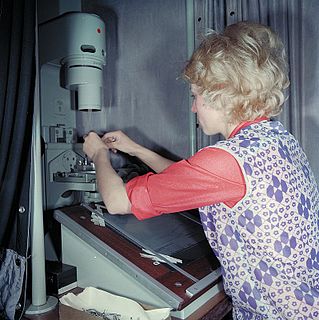Nondestructive testing (NDT) is a wide group of analysis techniques used in science and technology industry to evaluate the properties of a material, component or system without causing damage. The terms nondestructive examination (NDE), nondestructive inspection (NDI), and nondestructive evaluation (NDE) are also commonly used to describe this technology. Because NDT does not permanently alter the article being inspected, it is a highly valuable technique that can save both money and time in product evaluation, troubleshooting, and research. The six most frequently used NDT methods are eddy-current, magnetic-particle, liquid penetrant, radiographic, ultrasonic, and visual testing. NDT is commonly used in forensic engineering, mechanical engineering, petroleum engineering, electrical engineering, civil engineering, systems engineering, aeronautical engineering, medicine, and art. Innovations in the field of nondestructive testing have had a profound impact on medical imaging, including on echocardiography, medical ultrasonography, and digital radiography.

The flash point of a volatile material is the lowest temperature at which vapours of the material will ignite, when given an ignition source.
Dye penetrant inspection (DP), also called liquid penetrate inspection (LPI) or penetrant testing (PT), is a widely applied and low-cost inspection method used to check surface-breaking defects in all non-porous materials. The penetrant may be applied to all non-ferrous materials and ferrous materials, although for ferrous components magnetic-particle inspection is often used instead for its subsurface detection capability. LPI is used to detect casting, forging and welding surface defects such as hairline cracks, surface porosity, leaks in new products, and fatigue cracks on in-service components.
The dropping point of a lubricating grease is an indication of the heat resistance of the grease and is the temperature at which it passes from a semi-solid to a liquid state under specific test conditions. It is dependent on the type of thickener used and the cohesiveness of the oil and thickener of a grease. The dropping point indicates the upper temperature limit at which a grease retains its structure though is not necessarily the maximum temperature at which a grease can be used.
The American Petroleum Institute gravity, or API gravity, is a measure of how heavy or light a petroleum liquid is compared to water: if its API gravity is greater than 10, it is lighter and floats on water; if less than 10, it is heavier and sinks.
The Atterberg limits are a basic measure of the critical water contents of a fine-grained soil: its shrinkage limit, plastic limit, and liquid limit.
The pour point of a liquid is the temperature below which the liquid loses its flow characteristics. In crude oil a high pour point is generally associated with a high paraffin content, typically found in crude deriving from a larger proportion of plant material. That type of crude oil is mainly derived from a kerogen Type III.
The salt spray test is a standardized and popular corrosion test method, used to check corrosion resistance of materials and surface coatings. Usually, the materials to be tested are metallic and finished with a surface coating which is intended to provide a degree of corrosion protection to the underlying metal. Salt spray testing is an accelerated corrosion test that produces a corrosive attack to coated samples in order to evaluate the suitability of the coating for use as a protective finish. The appearance of corrosion products is evaluated after a pre-determined period of time. Test duration depends on the corrosion resistance of the coating; generally, the more corrosion resistant the coating is, the longer the period of testing before the appearance of corrosion/ rust. The salt spray test is one of the most widespread and long-established corrosion tests. ASTM B117 was the first internationally recognized salt spray standard, originally published in 1939. Other important relevant standards are ISO9227, JIS Z 2371 and ASTM G85.

A fire test is a means of determining whether fire protection products meet minimum performance criteria as set out in a building code or other applicable legislation. Successful tests in laboratories holding national accreditation for testing and certification result in the issuance of a certification listing. The listing is public domain, whereas the test report itself is proprietary information belonging to the test sponsor.

The Pensky–Martens closed-cup flash-point test is a test for the determination of the flash point of flammable liquids. It is standardized as ASTM D93, EN ISO 2719 and IP 34 The United States Environmental Protection Agency (EPA) has also published Method 1010A: Test Methods for Flash Point by Pensky-Martens Closed Cup Tester, part of Test Methods for Evaluating Solid Waste, Physical/Chemical Methods, which references the ASTM standard series D93. The Pensky-Martens test is a closed-cup method as opposed to the Cleveland open-cup method.

Bituminous waterproofing systems are designed to protect residential and commercial buildings. Bitumen is a mixed substance made up of organic liquids that are highly sticky, viscous, and waterproof. These systems are sometimes used to construct roofs, in the form of roofing felt or roll roofing products.
Reid vapor pressure (RVP) is a common measure of the volatility of gasoline and other petroleum products. It is defined as the absolute vapor pressure exerted by the vapor of the liquid and any dissolved gases/moisture at 37.8 °C (100 °F) as determined by the test method ASTM-D-323, which was first developed in 1930 and has been revised several times. The test method measures the vapor pressure of gasoline, volatile crude oil, jet fuels, naphtha, and other volatile petroleum products but is not applicable for liquefied petroleum gases. ASTM D323-15a requires that the sample be chilled to 0-1 degrees Celsius and then poured into the apparatus; for any material that solidifies at this temperature, this step cannot be performed. RVP is commonly reported in kilopascals or pounds per square inch and represents volatization at atmospheric pressure because ASTM-D-323 measures the gauge pressure of the sample in a non-evacuated chamber.

In the paint and coating industries, paint adhesion testing is often used to determine if the paint or coating will adhere properly to the substrates to which they are applied. There are several different tests to measure the resistance of paints and coatings from substrates: cross-cut test, scrape adhesion, pull-off test, and others.
Abrasion is the process of scuffing, scratching, wearing down, marring, or rubbing away. It can be intentionally imposed in a controlled process using an abrasive. Abrasion can be an undesirable effect of exposure to normal use or exposure to the elements.
A Hegman gauge, sometimes referred to as a grind gauge, grind gage, or grindometer, is an instrument which indicates the fineness of grind or the presence of coarse particles and agglomeration in a dispersion. It is commonly used to determine how finely ground the particles of pigment dispersed in a sample of paint are. This is important because many types of solid materials must be ground into finer particles in order to be dispersed in liquids. The resulting properties of the dispersion vary based on the size of individual particles and the degree which they are dispersed.

Package testing or packaging testing involves the measurement of a characteristic or property involved with packaging. This includes packaging materials, packaging components, primary packages, shipping containers, and unit loads, as well as the associated processes.
The Cleveland open-cup method is one of three main methods in chemistry for determining the flash point of a petroleum product using a Cleveland open-cup apparatus, also known as a Cleveland open-cup tester. First, the test cup of the apparatus is filled to a certain level with a portion of the product. Then, the temperature of this chemical is increased rapidly and then at a slow, constant rate as it approaches the theoretical flash point. The increase in temperature will cause the chemical to begin to produce flammable vapor in increasing quantities and density. The lowest temperature at which a small test flame passing over the surface of the liquid causes the vapor to ignite is considered the chemical's flash point. This apparatus may also be used to determine the chemical's fire point which is considered to have been reached when the application of the test flame produces at least five continuous seconds of ignition.Temperature range of this apparatus is 120 to 250 degree c
The color measurement of a liquid is the evaluation of that liquid's color properties. This is usually done through visual means, but can also be done by through automated means. The former provides approximate data, while the latter can provide objective data on the color properties of any given liquid.









